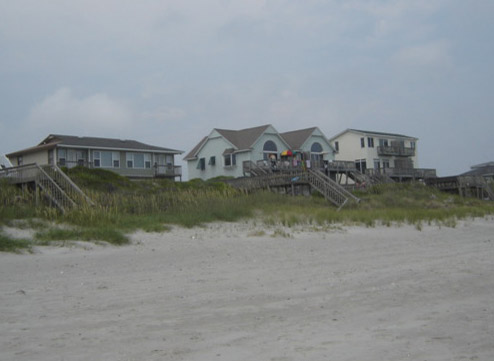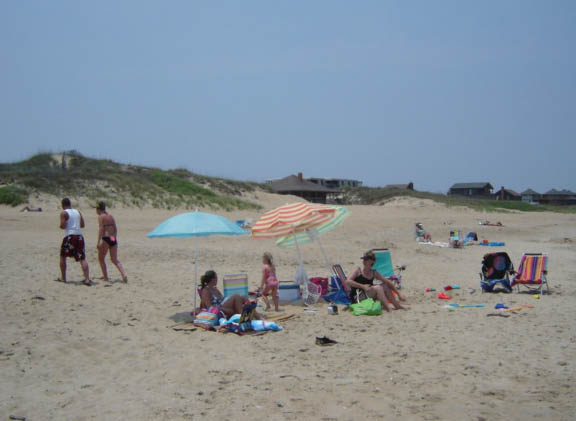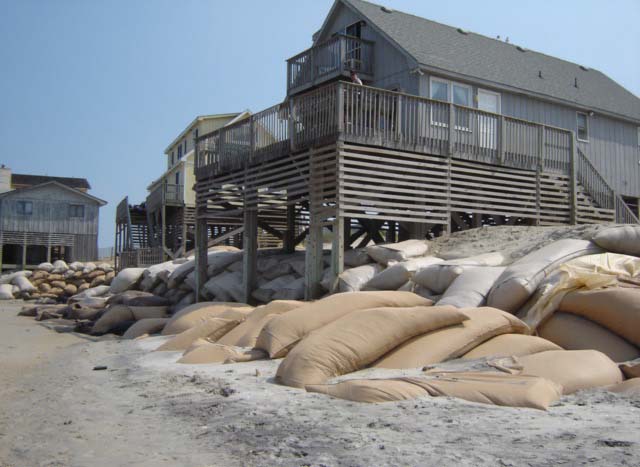WEAI/AERE 2009 - Individual Paper Abstract
Title: The Value of Disappearing Beaches in North Carolina: A Hedonic Pricing model with Endogenous Beach Width
Author(s): Sathya GOPALAKRISHNAN, Nicholas School of the Environment, Duke University, Box 90328, Durham, NC 27708, sg63@duke.edu, 919-613-8051; Jordan Slott, Sun Microsystems Inc., 35 Network Drive, Burlington, MA 01803; Martin Smith, Associate Professor of Environmental Economics, Nicholas School of the Environment & the Department of Economics, Duke University (photo credits: Sathya Gopalakrishnan)
Abstract:
Beach erosion and the associated benefits from wide beaches have been a concern for coastal managers for many years. Though changes in shoreline positions occur over very long time horizons, a gradual landward movement of the shoreline has been observed in many parts of the world. Simultaneously, there has been an increase in the population density in coastal towns in the United States (Pilkey et al. 1998), leading to a natural conflict that requires active policy intervention to manage coastal economies that thrive on tourism. Despite being an important policy issue with profound economic implications, beach management has received scant attention from resource economists until recently.
Beach nourishment has become a popular policy beach management option and is being implemented in many parts of the US Atlantic and Pacific coasts. Nourishment is the process of artificially rebuilding a beach by periodically placing sand dredged from off shore sources on an eroding section of the beach (Dean 2002). The benefits from beach nourishment include reduction in storm damage to ocean front property and recreational amenities from a wider beach, but the magnitude of these benefits is still not well understood. What is the economic value of increasing the width of a beach in a community? Are the costs of undertaking periodic beach nourishment projects justified by the damage to property that is averted? Are policy interventions aimed at stabilizing shorelines capitalized into property values? The answers to these questions require reliable estimates of the value of beach width as an essential first step.
Previous work in this area has consistently shown that there is a significant and positive influence of beach width on the value of coastal property (Brown and Pollakowski 1977; Parsons and Wu 1991; Edwards and Gable 1991; Parsons and Powell 2001; Kriesel et al. 1993; Pompe and Rinehart 1995; Landry et al. 2003; Bin et al. 2005). However, these studies have not considered the econometric implications of policy interventions in the coastal system and the feedback that beach nourishment has on the rate of shoreline retreat. We argue that because coastal property prices are a function of beach width and beach nourishment decisions affect that width, the width of a beach is an endogenous variable. Our paper fills a gap in the literature by incorporating the endogeneity of beach width in a first-stage hedonic property value model. Relying on knowledge of coastal geomorphology, we use instrumental variables to recover an unbiased and consistent estimate of the coefficient on beach width. Instrumenting for beach width dramatically changes the empirical results, suggesting that beach width is a much larger portion of property value than previously thought.
This paper also aims to bridge the gap between static, empirically based non-market valuation studies of beaches and conceptual resource economics models of dynamic decisions in the coastal zone. The results from the hedonic model can be used to test a dynamic capital-theoretic model of beach nourishment decisions (Smith et al., 2008). Our simulation results show that the predicted interval between nourishment projects using hedonic value of beach width accounting for endogeneity is closer to the observed data for the three beaches that have undertaken more than ten nourishment projects. Further, as sea level rise and potentially increased storminess due to climate change increase the demand for erosion control, the future availability of appropriate sand for beach nourishment is a serious concern for coastal managers. We run simulations to calculate nourishment intervals in scenarios with increased baseline erosion and increased variable costs of nourishment sand (due to scarcity). Our simulation results indicate that the value of coastal residential property can fall by as much as 97% when the baseline erosion doubles variable costs of sand quadruple.
These results raise important concerns about the sustainability of beach nourishment as a longrun policy option to manage eroding beaches, particularly with the increasing budget and resource constraints. The empirical analysis confirms that the value of beach nourishment is capitalized into coastal property value and motivates further research on the use of sand resource in the long run.



